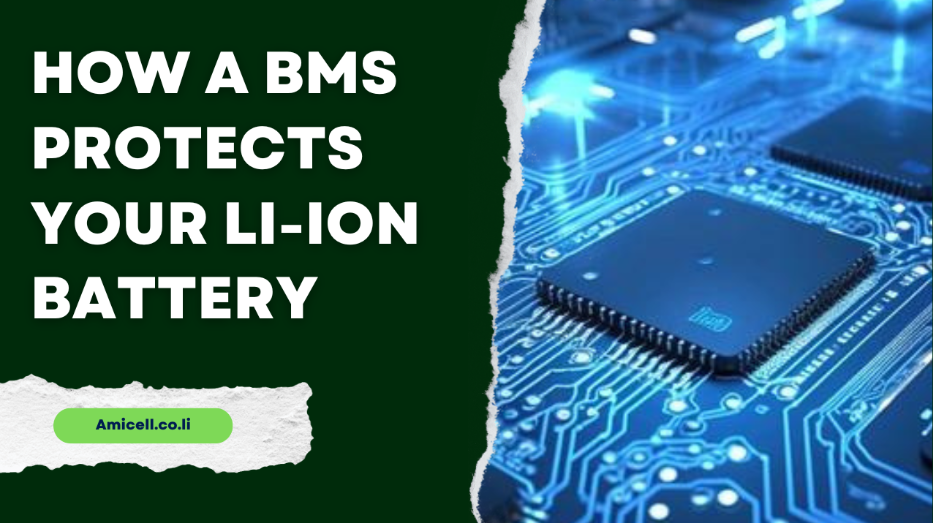BMS Design helps to protect your li-ion battery
A Li-ion battery BMS, or Battery Management System, is essential for the safe and efficient operation of lithium-ion batteries. These batteries, known for their high energy density and versatility, power a wide range of devices, from smartphones to electric vehicles.
However, their potential comes with inherent risks, such as overheating, overcharging, and deep discharging, which can lead to extending battery lifespan or even catastrophic failures. This is where a BMS comes into play.
By monitoring and managing the battery’s performance, a BMS ensures that it operates within safe parameters, protecting both the battery and the device it powers.
What is BMS in Battery?
An electronic regulator called a battery management system (BMS) keeps track of and regulates how rechargeable batteries are charged and discharged. The electronics application used in battery management systems could be as basic as measuring voltage and stopping the charging process when the target voltage is attained.
Most gadgets that employ rechargeable batteries use several sorts of battery management systems. They are also typical in data centers, where servers are kept online by UPS (uninterruptible power supplies). Battery management systems are found in everyday portable electronics like cell phones and MP3 players as well as vehicles, notably electric ones.
A more sophisticated BMS for lithium-ion batteries keeps track of numerous variables that affect battery performance and longevity in addition to assuring operational safety. They might keep an eye on single- or multiple-cell battery systems. Individual cell conditions can be monitored and managed via multi-cell systems.
The Importance of BMS Design in Lithium-Ion Batteries
The design of a Battery Management System (BMS) is crucial for the safety and efficiency of lithium-ion batteries. A well-designed BMS uses sensors and algorithms to monitor the battery’s state of charge, health, temperature, and voltage.
This ensures optimal performance, prevents overcharging, over-discharging, and overheating, and extends the battery’s lifespan. Effective BMS design is essential for maintaining battery health, enhancing safety, and maximizing the overall efficiency of lithium-ion batteries.
BMS Circuit Diagram for Lithium-Ion Batteries
A BMS circuit diagram for lithium-ion batteries typically includes components such as battery monitoring ICs, voltage sensors, temperature sensors, balancing circuits, and a microcontroller unit (MCU). These components work together to monitor and control the battery’s voltage, current, and temperature, ensuring safe operation and optimal performance while extending the battery’s lifespan.
How Battery Management Systems (BMS) Work
Battery Management Systems (BMS) work by continuously monitoring a battery’s state of charge, state of health, temperature, and voltage. Using sensors and processors, the BMS collects data and employs algorithms to manage charging and discharging processes.
It prevents overcharging, over-discharging, and overheating, ensuring safe and efficient operation. Additionally, a BMS balances the charge across individual cells, enhancing overall battery performance and lifespan.
Key Components in a BMS Circuit Diagram for Lithium-Ion Batteries
Understanding the key components in a BMS circuit diagram is essential for optimizing the performance and safety of lithium-ion batteries. Here are five crucial components:
- Battery Monitoring ICs
Battery Monitoring ICs are integrated circuits that monitor the voltage, current, and temperature of each cell in the battery pack, ensuring they operate within safe limits. - Voltage Sensors
Voltage sensors continuously measure the voltage of each cell, providing critical data to prevent overcharging and over-discharging, which can damage the battery and reduce its lifespan. - Temperature Sensors
Temperature sensors detect the temperature of the battery cells and the environment. This information is vital for preventing overheating and ensuring the battery operates within a safe temperature range. - Balancing Circuits
Balancing circuits manage the charge distribution among the cells in the battery pack, ensuring that all cells maintain a similar state of charge. This balance helps in extending the overall lifespan of the battery. - Microcontroller Unit (MCU)
The MCU is the brain of the BMS, processing data from the sensors and controlling the balancing circuits and safety mechanisms. It ensures the battery operates efficiently and safely by making real-time decisions.
Amicell Provides Lithium Battery with Safe and Reliable BMS
Amicell offers high-quality lithium batteries equipped with advanced Battery Management Systems (BMS) to ensure safety and reliability. Their BMS technology protects against overcharging, over-discharging, and overheating, enhancing battery performance and lifespan. With Amicell’s solutions, you can trust in efficient, long-lasting power for various applications, from portable electronics to electric vehicles.
How a BMS Protects Your Battery from Overcharging and Over-Discharging
A Battery Management System (BMS) protects your battery by monitoring its voltage levels. It prevents overcharging by disconnecting the charging source when the battery reaches its maximum voltage limit.
Similarly, it prevents over-discharging by cutting off the load when the voltage drops below a safe threshold. This ensures the battery operates within safe parameters, extending its lifespan and maintaining efficiency.
Conclusion
In conclusion, a Battery Management System (BMS) plays a critical role in safeguarding lithium-ion batteries and optimizing their performance. By monitoring key parameters such as state of charge, health, temperature, and voltage, a BMS ensures safe charging and discharging operations.
It prevents overcharging, over-discharging, and overheating, thereby extending the battery’s lifespan and maintaining efficiency. With the increasing importance of lithium-ion batteries in various applications, the role of BMS design becomes even more significant in ensuring reliable and sustainable energy storage solutions.
FAQs
- What happens if a Li-Ion battery doesn’t have a BMS?
Without a BMS, a Li-Ion battery is at risk of overcharging, over-discharging, and overheating, which can lead to reduced lifespan, safety hazards, and potential failure. - Can a BMS be used with other types of batteries?
Yes, BMS can be adapted for use with various types of batteries, including lead-acid, nickel-metal hydride, and more. - How does a BMS protect against overcharging?
A BMS protects against overcharging by continuously monitoring the battery’s voltage and disconnecting the charging source when the voltage reaches a preset limit. - What are the benefits of cell balancing in a BMS?
Cell balancing ensures that all cells in the battery pack maintain similar levels of charge, maximizing capacity, and extending the overall lifespan of the battery. - Can a BMS prevent short circuits?
Yes, a BMS includes short-circuit protection mechanisms that quickly detect and isolate any short circuits within the battery pack, preventing damage to the cells and ensuring safety.





